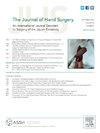Esmarch绷带在手部手术中的应用:历史回顾、临床应用和相关风险。
IF 2.1
2区 医学
Q2 ORTHOPEDICS
引用次数: 0
摘要
止血带对手外科的影响是毋庸置疑的。止血带为外科医生提供了相当大的效用,允许改善组织可视化和减少术中失血。虽然有许多肢体放血技术,但最常用的是使用薄而宽的弹性绷带,通常被称为“Esmarch绷带”。最早的“Esmarch绷带”发明于1873年,最初的“Esmarch绷带”是用编织橡胶绷带将手术肢体放血,然后在近端肢体上应用空心橡胶管,以提供无血的手术区域。约翰·弗里德里希·奥古斯特·冯·埃斯马奇的贡献主要是他维持肢体缺血的方式,因为用于止血的绷带之前已经由其他人开发出来了。尽管现在的“埃斯马奇绷带”与他19世纪发明的橡胶管几乎没有什么相似之处,但他的影响还是通过使用薄而有弹性的绷带来纪念。在这篇文章中,我们总结了手外科背景下现代Esmarch绷带的历史、用途、并发症和目前的建议。本文章由计算机程序翻译,如有差异,请以英文原文为准。
The Esmarch Bandage in Hand Surgery: Historical Overview, Clinical Utility, and Associated Risks
There is no debating the impact of tourniquets on the field of hand surgery. Tourniquets provide considerable utility for surgeons, allowing improved tissue visualization and reduced intraoperative blood loss. Although there are a number of limb exsanguination techniques, the most common is the use of a thin, wide elastic bandage, commonly referred to as the “Esmarch bandage.” Described in 1873, the original “Esmarch bandage” exsanguinated the operative limb with a woven rubber bandage before application of a hollow rubber tube on the proximal limb to provide a bloodless surgical field. Johann Friedrich August von Esmarch’s contribution was primarily the manner in which he maintained limb ischemia as the bandage used for exsanguination had been previously developed by others. von Esmarch’s impact has nevertheless been memorialized by the use of thin, elastic bandage, despite the fact that the current “Esmarch bandage” bears little resemblance to his 19th century rubber tube. In this manuscript, we summarize the history, utility, complications, and current recommendations associated with the modern Esmarch bandage within the context of hand surgery.
求助全文
通过发布文献求助,成功后即可免费获取论文全文。
去求助
来源期刊
CiteScore
3.20
自引率
10.50%
发文量
402
审稿时长
12 weeks
期刊介绍:
The Journal of Hand Surgery publishes original, peer-reviewed articles related to the pathophysiology, diagnosis, and treatment of diseases and conditions of the upper extremity; these include both clinical and basic science studies, along with case reports. Special features include Review Articles (including Current Concepts and The Hand Surgery Landscape), Reviews of Books and Media, and Letters to the Editor.

 求助内容:
求助内容: 应助结果提醒方式:
应助结果提醒方式:


